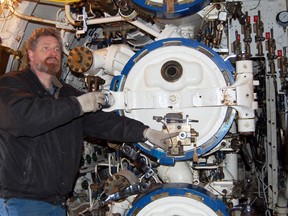Welcome aboard Ojibwa!

Article content
As opening day approaches, area media were invited to tour the former HMCS Ojibwa Friday morning in Port Burwell.
A complete tour of the decommissioned cold war-era submarine was given by Elgin Military Museum officials and Ojibwa restoration personnel.
“Welcome aboard. What we’re going to be doing today is we’re revealing her mysteries in gradual stages,” said Ian Raven, executive director for the Elgin Military Museum.
The tour began at the bow of the submarine, in what is called the torpedo room.
“This is the fighting compartment of the boat – there were racks here on the sides that would hold the torpedoes. Her normal war load if she was leaving harbour on a mission would be 22 torpedoes - 6 in the tubes and 16 more on these racks,” said Raven.
The torpedo room, although small, was equipped to hold all 70 submariners onboard in case of an emergency and evacuation, housing one of the escape hatches.
From the torpedo room and through the first of four water-tight doors, 36 inches in diameter, visitors enter one of several accommodations rooms.
A small area slept up to 18 individuals. In this room, along with beds were portable lockers, where submariners would store their belongings for a three-month trip.
“There’s a lower bunk, a mid-level bunk and a high-level bunk. The bunks are about six feet long,” said Raven. “This space would be for ordinary seamen.”
Raven and restoration technician Dean Lewis, noted that every submariner onboard had to have a working knowledge of all of the systems of the boat – which took approximately seven to 12 months to learn.
“You’ve got to train with a qualified submariner on every detail – like how do I open the torpedo tubes?” said former Ojibwa submariner Dean Lewis. “It’s not my job but if I don’t know how to do it, then I potentially could kill everybody on board.
“If you don’t know everything 100%, you don’t get your dolphins – which are like wings for a pilot.”
Continuing through the submarine, visitors will experience narrow passages and small spaces that submariners had to work and live in for several weeks or months at a time.
Sections of the submarine include officers’ quarters, the engine room, motor room, sonar room – where Lewis himself spent much of his time as a sonar operator onboard Ojibwa - the kitchen where meals were prepared, and the control room are other areas visitors will see.
“Most of the time when taking our tours, there was often water restrictions, so you weren’t allowed to shower – the only people that would have a shower are the cooks and the medic because they were dealing with food and people,” said Lewis, as he guided several media members through the submarine. “Through the reverse osmosis system onboard, we could only make 60 gallons of fresh water out of the salt water in a day, so that was mostly for cooking.”
In the control room Lewis spoke of a ‘one man control’ section of Ojibwa - a position operated by the ‘helmsman’ – the submariner who basically steered and controlled the entire submarine.
“One guy would sit there and he would do both the direction and the depth. It’s probably one of the hardest jobs onboard.”
The radio room also served an important purpose.
“They would pass a note to the captain or top-secret information, a change in what our job description was, or new orders, whatever it could be. Some of it was cryptographted, some of it wasn’t.”
It was for the captain, from the military explained Lewis.
“In a lot of cases they would pass it back and forth so that you were ensuring that you were doing the orders that were sent out by military command.”
Melissa Raven, director of communications for Project Ojibwa, said that while the equipment for the radio room is gone, there will be an operational radio room on Ojibwa when it opens this summer.
Three men worked usually in the part of Ojibwa known as the engine room.
“They have all kinds of valves they have to operate when the engines are running or when shutting down the engines – if radar showed up, everything that they just did, they’d have to reverse it and you’d have to do it in seconds,” said Lewis. “So they were highly trained to be able to shut down the diesels without the radar from an aircraft being able to detect the submarines.”
Outside the motor room Lewis pointed out graffiti, which was most likely done during the Ojibwa’s final tour. Graffiti left by the submariners includes a couple of fun quotes and the names of some of the ports or places visited while on its last tour, including New York City, Boston, St. John’s, Charlottetown, Vancouver, and Portland, Maine.
Media were allowed to take photos of the torpedo and accommodations rooms, along with the exterior of the submarine.
For more information on Project Ojibwa visit www.projectojibwa.ca.